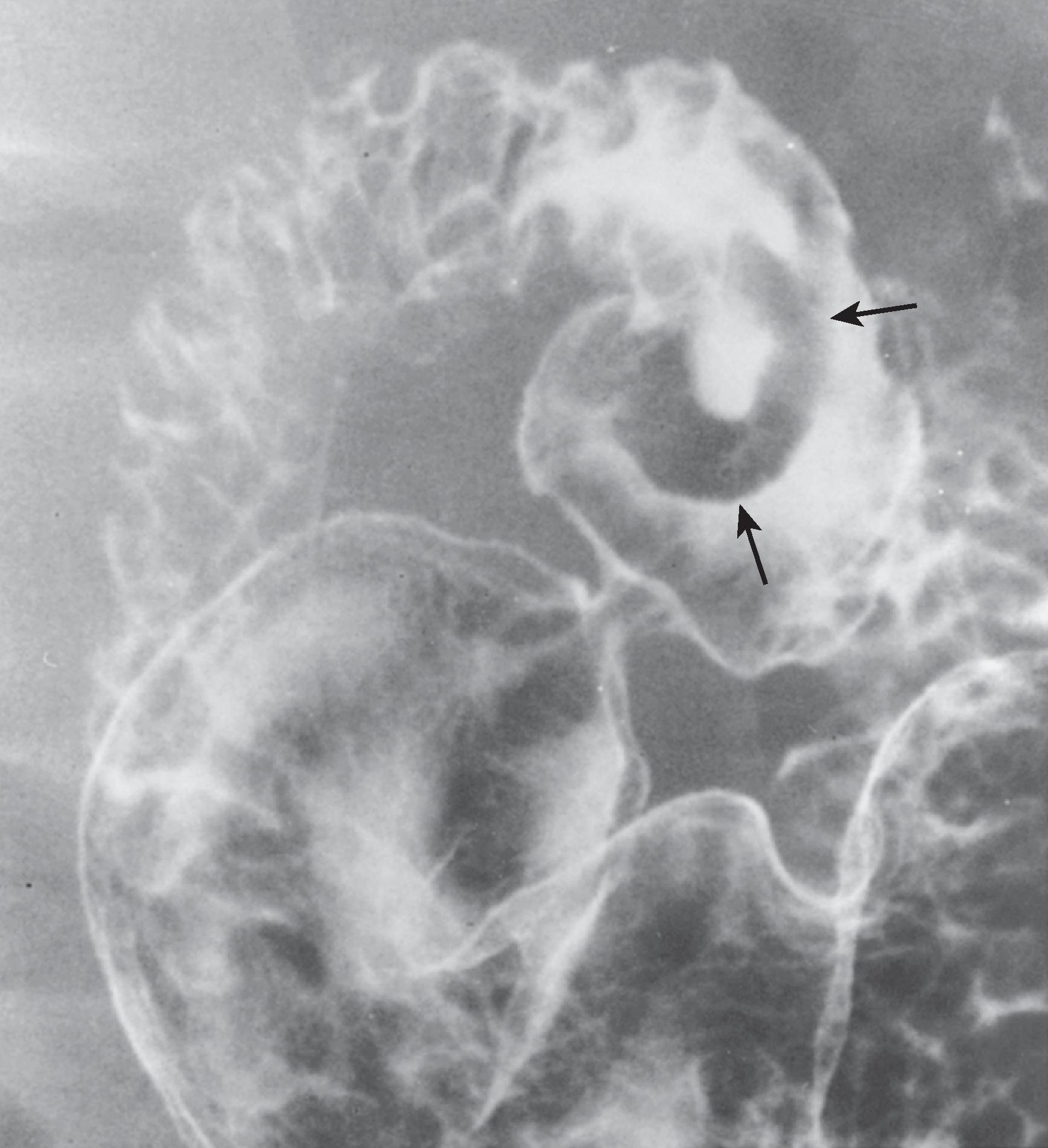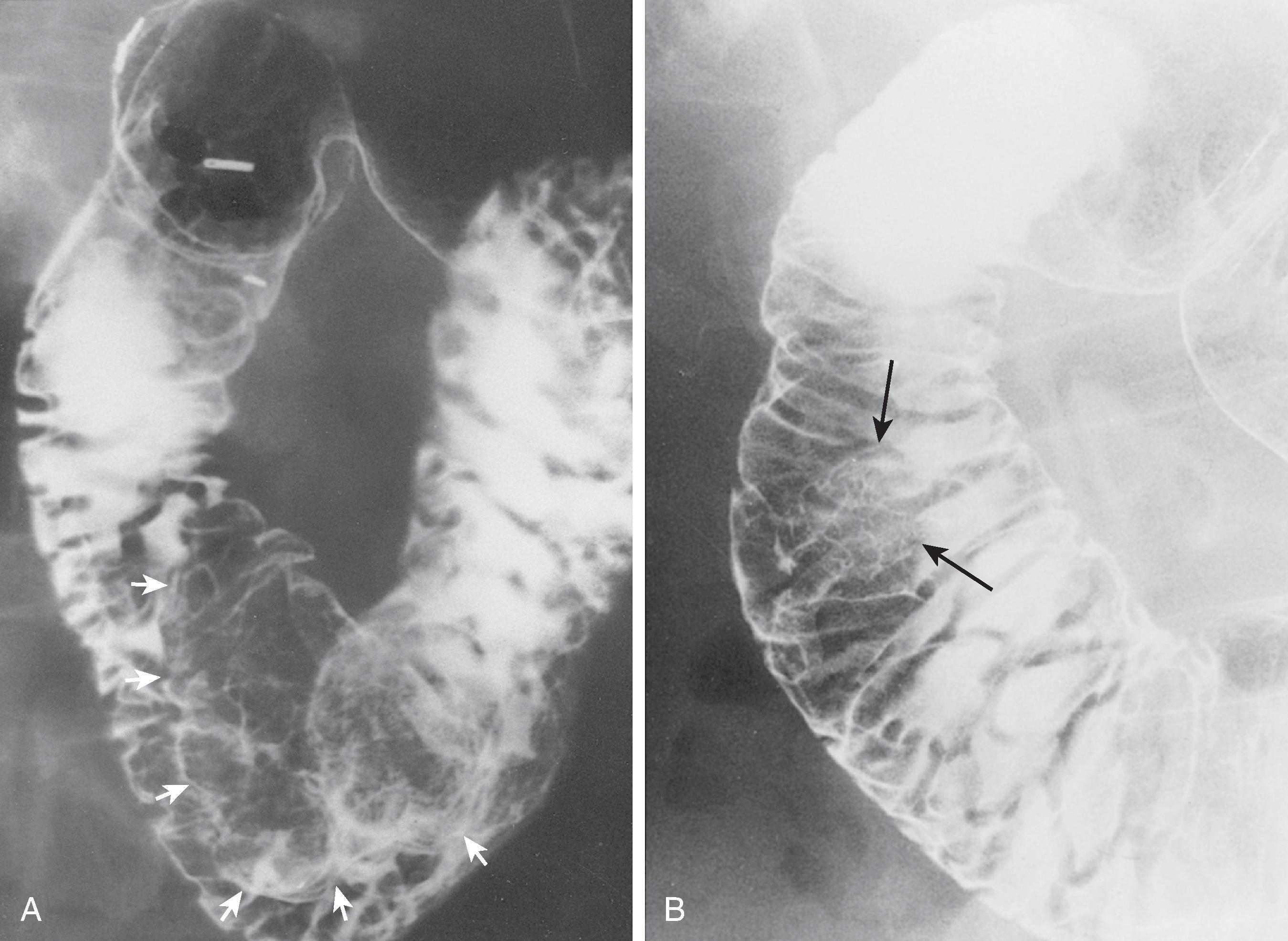Physical Address
304 North Cardinal St.
Dorchester Center, MA 02124
Between 85% and 90% of neoplasms in the stomach and duodenum are benign. About 50% are mucosal lesions and 50% are submucosal. Most benign neoplasms are discovered fortuitously on barium studies or endoscopy, but large or ulcerated tumors may cause abdominal pain or upper gastrointestinal (GI) bleeding. Others are important because of the risk of malignant degeneration.
Polyps constitute about 50% of benign neoplasms in the stomach but are rarely encountered in the duodenum. Most are innocuous hyperplastic polyps, but a small percentage are adenomatous polyps that are premalignant. The histology of gastric polyps is directly related to their size and appearance, so radiologists have an important role in detecting these polyps and guiding patient management.
Hyperplastic polyps are by far the most common benign epithelial neoplasms in the stomach, comprising 75% to 90% of gastric polyps. They consist histologically of elongated, branching, cystically dilated glandular structures and usually appear grossly as multiple small (<1 cm), round nodules in the gastric fundus and body. Hyperplastic polyps have no malignant potential, so there is no risk of developing cancer in these lesions.
Fundic gland polyps are a variant of hyperplastic polyps arising within the fundic gland mucosa in the proximal stomach. These lesions consist histologically of cystically dilated, hyperplastic fundic glands and appear grossly as multiple small nodules indistinguishable from hyperplastic polyps. Like hyperplastic polyps, fundic gland polyps have no malignant potential. Multiple fundic gland polyps (also known as fundic gland polyposis ) can occur as an isolated condition in the stomach or, less commonly, as a component of familial adenomatous polyposis syndrome (FAPS). Thus, colonoscopy is often recommended for patients with fundic gland polyposis to determine whether they have FAPS and whether colonic surveillance is warranted.
Most hyperplastic and fundic gland polyps are detected as incidental findings on barium studies or endoscopy. Occasionally, however, friable polyps cause low-grade upper GI bleeding, and pedunculated polyps in the distal antrum even prolapse through the pylorus, causing intermittent gastric outlet obstruction. For reasons that are unclear, fundic gland polyps are most commonly found in middle-aged women. ,
Hyperplastic gastric polyps typically appear on double-contrast studies as small (<1 cm), sessile, round or ovoid nodules. They often occur as multiple lesions, predominantly in the gastric fundus and body ( Fig. 19.1 ). Hyperplastic polyps on the dependent surface of the stomach (the posterior wall) typically appear as round filling defects in the thin barium pool, whereas those on the nondependent surface (the anterior wall) appear as ring shadows etched in white (see Fig. 19.1A ). Small hanging droplets of barium (i.e., stalactites) on nondependent polyps can be mistaken for central ulcers (see Fig. 19.1B ) but are observed as a transient finding at fluoroscopy.

Although quite uncommon, atypical hyperplastic polyps are large (2 to 6 cm), lobulated, or pedunculated lesions ( Fig. 19.2 ). , A conglomerate mass of hyperplastic polyps can even be mistaken for a polypoid gastric carcinoma ( Fig. 19.3 ). , Rarely, pedunculated hyperplastic polyps in the distal antrum prolapse through the pylorus into the duodenum bulb ( Fig. 19.4 ), causing intermittent gastric outlet obstruction.



Fundic gland polyps typically appear as multiple small (<1 cm), round fundal nodules indistinguishable from hyperplastic polyps ( Fig. 19.5 ). , Spontaneous regression of fundic gland polyps has occasionally been reported.

Hyperplastic polyps that appear as ring shadows on double-contrast barium studies can usually be differentiated from shallow ulcers on the dependent (posterior) gastric wall and from unfilled ulcers on the nondependent (anterior) wall by a combination of flow technique and prone compression. However, atypical hyperplastic polyps that are unusually large or lobulated cannot be distinguished from adenomatous polyps or even early cancers. Rarely, a conglomerate mass of hyperplastic polyps can mimic a polypoid carcinoma (see Fig. 19.3 ). ,
The differential diagnosis for multiple hyperplastic polyps in the stomach includes multiple adenomatous polyps, but the latter polyps tend to be larger, more lobulated, and less numerous. A generalized polyposis syndrome involving the stomach should be suspected if multiple polyps are also present in the small bowel or colon (see Chapter 45).
Small (<1 cm), smooth, round polyps detected in the stomach on double-contrast studies should be considered innocuous hyperplastic polyps without need for further evaluation. Occasionally, however, endoscopic biopsy or polypectomy is required for atypical hyperplastic polyps that are lobulated, pedunculated, or larger than 1 cm.
Adenomatous polyps constitute less than 20% of all gastric polyps, , Depending on the glandular architecture, adenomatous polyps are classified as tubular, villous, or tubulovillous adenomas; the vast majority are tubular or mixed tubulovillous adenomas. Unlike hyperplastic polyps, adenomatous polyps in the stomach can undergo malignant degeneration via an adenoma-carcinoma sequence similar to that in the colon. Foci of carcinoma in situ or invasive carcinoma are present in nearly 50% of resected adenomatous polyps larger than 2 cm but are rarely found in smaller lesions. The risk of malignancy is therefore directly related to polyp size. Nevertheless, adenocarcinoma is 30 times more common than adenomatous polyps in the stomach, so the vast majority of cancers originate de novo and not from preexisting polyps.
Because of their larger size, adenomatous gastric polyps are more likely to cause symptoms than hyperplastic polyps. Affected individuals may present with epigastric pain, bloating, upper GI bleeding or, rarely, gastric outlet obstruction if a pedunculated antral polyp prolapses through the pylorus into the duodenal bulb.
Most adenomatous polyps detected in the stomach on barium studies are larger than 1 cm, and they are often lobulated or pedunculated ( Figs. 19.6 and 19.7 ). , The stalk of a pedunculated polyp may be seen en face as an inner ring shadow overlying the head of the polyp, producing a Mexican hat sign (see Fig. 19.6 ). Adenomatous polyps tend to occur as solitary lesions, most frequently in the antrum (see Fig. 19.6 ), , but multiple adenomatous polyps are sometimes found (see Fig. 19.7 ).


Adenomatous polyps in the stomach can usually be differentiated on barium studies from hyperplastic polyps because they are larger and more lobulated or pedunculated and often occur as solitary lesions in the distal stomach. Large adenomatous polyps that have a smooth contour can also be mistaken for gastrointestinal stromal tumors (GISTs) or other submucosal lesions, whereas an unusually large, lobulated polyp may be indistinguishable from a polypoid carcinoma (see Fig. 19.7 ).
When a gastric polyp is found on barium studies, endoscopic biopsy specimens should be obtained if the lesion is larger than 1 cm, lobulated, or pedunculated. If biopsy specimens reveal an adenomatous polyp, an endoscopic polypectomy should be performed because of the risk of malignant degeneration. In contrast, polyps larger than 2 cm should always be removed because of an even greater likelihood that they are adenomatous and the high risk of malignant tumor in adenomatous polyps of this size. If invasive carcinoma is found in the resected specimen, a partial gastrectomy may be required. An aggressive approach is therefore warranted in the management of adenomatous polyps because of their associated cancer risk.
Duodenal polyps are much less common than gastric polyps, and most are adenomatous. Because these polyps rarely cause symptoms, they are usually detected as incidental findings on barium studies or endoscopy. Occasionally, however, duodenal polyps cause low-grade upper GI bleeding (if they are friable) or obstructive jaundice (if they occlude the papilla of Vater).
Duodenal polyps usually appear on barium studies as smooth, sessile protrusions in the proximal duodenum ( Fig. 19.8 ). The vast majority are less than 2 cm, but giant duodenal polyps have occasionally been described. Although most duodenal polyps occur as solitary lesions, multiple polyps can be found in the duodenum as part of a polyposis syndrome (see Chapter 45).

Sessile polyps in the duodenum may be difficult to differentiate on barium studies from benign GISTs, Brunner gland hamartomas, or other submucosal masses, so endoscopy is often required for a definitive diagnosis. Occasionally, a pedunculated antral polyp or antral mucosa that has prolapsed through the pylorus can be mistaken for a polypoid lesion in the duodenum (see Fig. 19.4 ), but prolapsed antral mucosa often produces a distinctive mushroom-shaped defect at the base of the bulb ( Fig. 19.9 ). Apparent polypoid lesions can also result from heaped-up areas of redundant mucosa on the inner aspect of the superior duodenal flexure between the first and second portions of the duodenum ( Fig. 19.10 ). However, these “flexural” pseudolesions can usually be differentiated from true polypoid lesions by their characteristic location and appearance at fluoroscopy.


Adenomatous polyps in the stomach or duodenum that are composed of predominantly villous elements are often called villous adenomas. Because of their malignant potential, however, the term villous tumor is preferred by many authors to avoid the erroneous impression that these lesions are always benign. ,
Villous tumors are more common in the duodenum than in the stomach, appearing as relatively flat protruded lesions containing numerous frondlike projections. They usually range from 3 to 9 cm in size, but giant villous tumors as large as 15 cm have been reported. These tumors are most commonly found in the periampullary descending duodenum. ,
Villous tumors in the stomach or duodenum are associated with an even higher risk of malignant degeneration than those in the colon. The risk of malignancy is directly related to the size of the tumor. Malignant changes are found in 50% of gastric lesions larger than 2 cm in size and in 80% larger than 4 cm. Similarly, malignant changes are found in 30% to 60% of duodenal lesions, with the highest cancer risk in those larger than 4 cm. , All villous tumors in the stomach or duodenum should therefore be treated as malignant lesions.
Most patients with villous tumors in the stomach or duodenum are over 50 years of age. Affected individuals may present with signs or symptoms of upper GI bleeding, such as melena, guaiac-positive stool, and iron-deficiency anemia. Villous tumors in the duodenum occasionally cause obstructive jaundice if they occlude the papilla of Vater. Unlike villous tumors in the colon, however, those in the stomach and duodenum rarely cause diarrhea or electrolyte depletion.
Villous tumors in the stomach or duodenum should be resected because of the high risk of malignant change. Some benign lesions can be removed at endoscopy, but those harboring invasive cancer usually require surgery.
Villous tumors in the stomach or duodenum typically appear on barium studies as protruded lesions that have a finely nodular, reticular, or soap bubble appearance and serrated margins secondary to trapping of barium in multiple clefts between the frondlike projections of the tumor ( Figs. 19.11 and 19.12 ). These lesions therefore have radiographic features similar to those of villous tumors in the colon.


Villous tumors in the duodenum tend to be located in the periampullary region (see Fig. 19.12 ). These lesions may be obscured by superimposed duodenal folds, so they are best seen on double-contrast studies in which the duodenum is optimally distended.
A large villous tumor in the stomach can resemble a gastric bezoar when it has a soap bubble appearance secondary to barium trapping in the interstices of the tumor (see Fig. 19.11 ). However, the freely mobile nature of a bezoar with changes in patient position should suggest the correct diagnosis.
Become a Clinical Tree membership for Full access and enjoy Unlimited articles
If you are a member. Log in here